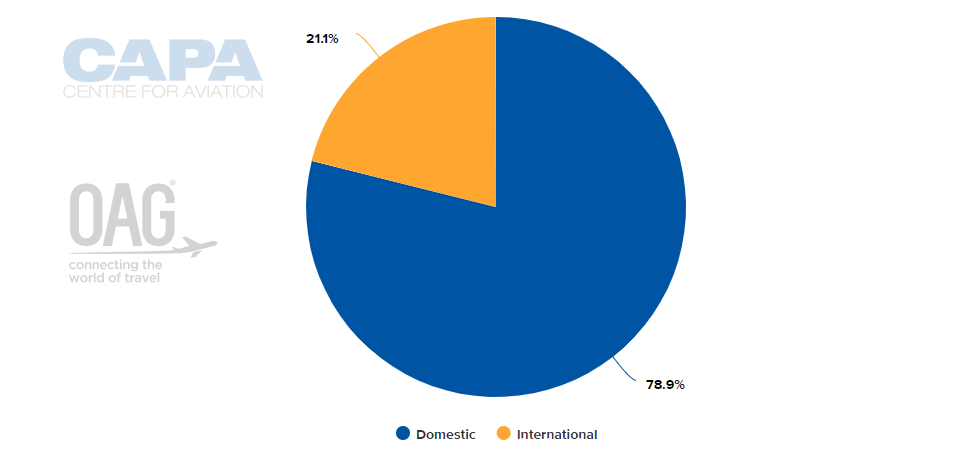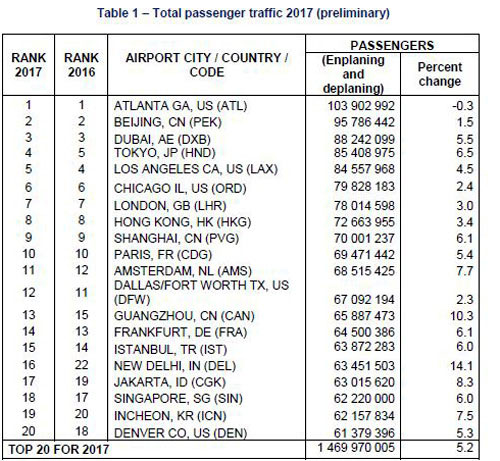Summary:
- Atlanta Hartsfield-Jackson International keeps its 'World's Busiest Airport' tag but is being challenged for the top spot by fast growing Dubai International;
- A new airport for Beijing and its own growth could enable Tokyo Haneda creep into the podium positions in third spot;
- Istanbul's main Atatürk Airport is growing once again but it will soon close as a New Istanbul Airport provides for the city's future;
- The biggest passenger gains are being made in Asia as air transport continues to grow.
Coming up on the rails is Beijing Capital Airport, which grew by +1.5% to 95.78 million in 2017 but its annual total is bound to be influenced by the opening of the Daxing airport, scheduled for Oct-2019, and capable in its initial stage of 45 million ppa.
Much the same could be true of Dubai, where there already are two airports, International and Al Maktoum International at World Central, but in that case most of the development, and the growth, is to be found at International, the home of Emirates Airline. Emirates has no passenger airline presence at Al Maktoum though it does have with its SkyCargo division, which has over 40 routes.
flydubai is the emirate's representative at Al Maktoum, which is developing as more of a cargo airport with an attendant 'airport city.' Its passenger total for 2017 was 900,000. If Dubai International keeps on growing at 5.5% per annum though, it could overtake Atlanta in three years assuming static growth at the big southeast US hub.
A mention also to Tokyo Haneda, which, with the 'domestic only' shackles removed continues to pick up new international travellers and which grew by an impressive +6.5% in 2017, a percentage point more than Dubai.
CHART - Over one-fifth of Tokyo Haneda's seats now are on international services and while China and South Korea are its biggest markets, it is notable that the US is third Source: CAPA - Centre for Aviation and OAG (data: w/c 07-May-2018)
Source: CAPA - Centre for Aviation and OAG (data: w/c 07-May-2018)
Of the major European airports, Amsterdam Schiphol recorded the greatest growth at +7.7%, followed by Frankfurt (+6.1%), Paris CDG (+5.4%) and London Heathrow (+3.0%). Somehow they keep digging out more space for more capacity at Heathrow and it is a sobering thought as to whether the capacity issue there has been a little overplayed in order to gain maximum publicity for the airport's campaign for a third runway.
Istanbul's Atatürk Airport is back in growth again in 2017, with an annual increase of +6%. The terrorist attacks and failed coup attempt of 2016 seem to have become a faded memory amongst many travellers, especially those that use Atatürk as a transit airport, but that won't stop it closing its doors to commercial service in 2019 when the Istanbul New Airport opens, taking on a new role with general aviation, flight training schools and MRO workshops. It will be interesting to see how quickly the new airport will enter the Top 20 list.
As is often the case the largest percentage gains were made in economically "emerging" countries though that phrase is not really applicable any longer to the likes of China, India or even Indonesia. Those three countries are responsible for figures of +14.1% (New Delhi), +10.3% (Guangzhou) and +8.3% (Jakarta).
The 20 airports are well-spread geographically, with five of them in North America, five in Europe, eight in Asia and one in the Middle East. As ever, both Latin America and Africa are conspicuous by their absence.
TABLE - Preliminary figures for the world's top 20 airports in 2017 show a combined +5.2% year-on-year rate of growth. More than half (13) exceeded that rate of growth with just Atlanta - the world's largest - witnessing a traffic decline Source: ACI World
Source: ACI World